






























































































































Artificial intelligence was once thought of as a form of technology that would be used in a far-flung “Star Trek”-like future, but in the past few years it has managed to become nearly as ubiquitous as the internet.
Like any other tool, it can be used to help a person with even the most miniscule of tasks or it can be utilized to upend someone’s life, or be employed for other destructive purposes.
Assemblyman Clyde Vanel (D-Queens Village), chairman of the Subcommittee on Internet and New Technology, has introduced 11 bills to protect people from some of the potential harms AI software may present.
Vanel recently shared his thoughts on the pros and cons of AI with the Chronicle.
“The advancement of technology is happening,” Vanel said. “What we can do is control it, what we can do is learn it, what we can do is help guide what it looks like, and I think that it is important for us to have efforts to do so in Queens.”
One piece of legislation from Vanel that is helping to lead those efforts is A10103B, a generative AI warnings bill. If enacted it would require firms to have conspicuous notifications on their websites alerting users that the technology may produce inappropriate or inaccurate information.
The bill was introduced May 7 after an April 26 report by City & State detailed how the assemblyman and several other state legislators were falsely accused of sexual harassment, being stripped of their committee assignments and quitting their jobs in shame in messages generated in response to a user’s prompt on Facebook’s new Meta AI chatbot.
“It was a full story,” Vanel said. “What we found out with generative AI and large-language models is that there is something called hallucinations — the results can be wrong.”

munication using AI to be disclosed. A06790A would classify the dissemination of synthetic media 60 days before an election as a Class E felony, while A06775 would make it a crime to share fabricated photos, videos or audio recordings. A10374 would prohibit the operation, sale, modification, transfer or equipping of robotic devices with a mounted weapon, whereas A09559 would create a commission to investigage and study how to regulate AI, robotics and automation.

After discovering there was no legislation to address the “hallucination,” Vanel reached out to AI firms and conducted an unofficial audit of eight chatbots.
“What I understand from this technology is that it needs inputs to get smarter,” he said. “The more inputs that they have the smarter they get, so they are going to get smarter over time, but inherently they are going to make mistakes. What’s important is that we want to live in a world where the developers have enough space to innovate and be able to make fair mistakes. We also want users to be aware the results can be wrong or innappropriate.”
Vanel said he doesn’t believe that he or his colleagues were being targeted and instead considers the mistake by the chatbot a blessing in disguise.
“The nature of the technology is good input, good output; not enough input, not too good output,” said Vanel about the tool that has been available to the general population for less than two years. “It got our attention.”
Other Vanel bills include A09103 and A07904A, which would require political com-
A08129 and A08195 would enact an AI Bill of Rights and licensing act, respectively.
A08105A would require the collection of oaths of responsible use of AI and the transmission of such oaths to the state Attorney General’s Office, while A10494 would impose liabilities for harmful or misleading information that results in financial loss or demonstrable harm.
On May 7, various state senators, with the support of members of entertainment unions, rallied for a package of AI labor and consumer protection bills.
The bills, S7676, S7422 and S6859 would require contracts involving the use of digital replicas of performers, remove film tax incentives on productions that displace employees with AI and necessitate the disclosure of AI ads being used in any medium, respectively.
State Sen. Mike Gianaris (D-Astoria), who introduced S6859, said the film and TV industry are integral parts of the state’s economy and he will not stop fighing for the workers who power the industry.
“My legislation would prevent workers from being deceptively replaced by artificial media, and would keep companies honest about using these tools,” Gianaris said in a statement.
Vanel said people in all industries should be concerned about how AI can affect their job.
“That’s why we should control it, not ignore it,” he said. “It’s going to and currently affects every job ...
Business of all kinds are incorporating AI into what they do.
Dawn Kelly, the owner of The Nourish Spot juice bar in Jamaica, told the Chronicle that while it took her a minute to learn how to use the technology, it has enhanced her business.
“I use it to create follow-up notes for people who I meet at networking events and I use it to create business proposals,” said Kelly, who also has used it generate tweets that have gone viral. “I’m trying to expand and grow my business. The only way to do that is to use technology that cuts down on how much I have to engage.”
One social media post that was enhanced by a chatbot helped her get catering work with Mastercard.
Jade Duncan, the chief operating officer of The Nourish Spot, said AI chatbots help the juice bar’s posts become more nuanced for the audience they are catering too.
At a Queens Innovation Foundation technology forum at Citi Field on June 4, business leaders using AI shared how entrepreneurs can use the technology to enhance their business.
“I’m not going to put a judgment on whether it will affect it positively or negatively; it’s a tool. We have to properly understand what the benefits of the tools are and what the harms of the tools are. It’s not inherently good or inherently bad.”
Vanel said there is nothing wrong with using AI as a tool in law, medicine, housing, education and more, but people should be cautious of the high risks.
“Light-level concerns are equity,” he said. “If the system is choosing who is getting certain types of treatment, it is important that the algorithm does not discriminate against people. We should be concerned about the wrong medical results as a high risk ... We always have to make sure the decision making is human-centric, meaning there is a human in the middle of the decision making. There is a human checking to see the results are correct.”
When it comes to education, Vanel doesn’t think it’s hypocritical for teachers to use AI to check if a student’s paper is being generated by AI, but he doesn’t believe schools should completely ban or allow work to be 100 percent artificially composed.
On Dec. 5, 2023, Councilwoman Jennifer Gutiérrez (D-Brookly, Queens), chairwoman of the Committee on Technology, presided over a joint hearing between the committees on technology and education.
The following day, the Council approved resolutions 0742, 0766 and 0767, which allow the city Department of Education to develop curriculum on generative AI and its safe use, especially in inner city schools, and allow educators to be trained for the technology.
The bills were introduced by Councilmembers Rita Joseph (D-Flatbush) and Shaun Abreu (D-Manhattan).
“Because of AI’s tremendous potential to benefit those in education, it is essential to ensure its ethical use and that it enhances rather than detracts from the educational experiences of our city’s students and teachers,” said Gutiérrez at the hearing.
“Verizon has been using AI for over a decade now ... for efficiency,” said Arvind Rajagopalan, associate vice president of data engineering, architecture and products for the communications giant, told the Chronicle. “More recently, we are using generative AI ... and today we talked about how companies can use it to improve customer loyalty, provide better customer experiences and overall drive better outcomes for customers.”
For example, Rajagopalan said, AI can be used to track trends in retail stores, helping people identify what the customers want.
Tom Grech, the president and CEO of the Queens Chamber of Commerce, was one of the people who had a hand in launching the foundation.
“We want Queens to be an international tech hub because of our international repute,” Grech told the Chronicle. “We have people from all over the world, great access to technology ... we have seven colleges and universities that are on the forefront.”
Out of the 3,000 counties throughout the country, the World’s Borough is the most diverse and has people who speak languages from all over the globe, which will be an asset in this new AI frontier, said Grech.
“AI tools will allow companies to grow and scale quickly and efficiently like never before, allowing them to grow bigger with less capital ... If we were our own city, we would be the fourth largest in America. That wind is at our back to grab the opportunity.” Q








































To travelers out of Queens who are frustrated with tedious security lines and scrambling to catch flights despite arriving three hours early: Fear no longer.
From alternative power sources to streamlined security, airports are leveraging technology to maximize the passenger experience from the ground to the air and back.
LaGuardia Airport’s Terminal B earned its second Leadership in Energy and Environmental Design gold certification in April for operations and maintenance. Following its LEED gold v4 certification for design and construction in 2021, the award recognizes the facility’s performance in the year following its completion.
The redevelopment was part of the $8 billion project that began in 2016 to construct a brand-new LGA.
Terminal B’s new three-level baggage handling system can move more than 3,200 bags per hour with 55 autonomous mobile inspection tables. Once baggage is loaded onto the tables, it gets delivered to a TSA agent for search, eliminating the need for additional lifting, and back onto the appropriate conveyor. The system reduces noise pollution and works more quickly than previous manpower-reliant technology.
It can also enter sleep mode when not in use, conserving more than 35 percent of energy compared to standard technology, and uses permanent magnetic motors to maneuver bags with maximal control.
The terminal also enhances energy efficiency by using natural light, a programmable lighting system and an HVAC system to use outdoor air for energy when possible.
Other key factors in the new

LEED award were rooftop solar hotwater systems to supplement the domestic hot-water supply for restrooms and a 500 percent increase in organic waste diversion.
The improvements marked by the certification contribute to the Port Authority of New York and New Jersey’s goal of net-zero greenhouse gas emissions by 2050.
In alignment with that commitment, Kennedy Airport’s New Terminal One CEO Jennifer Aument said sustainability is embedded in the project’s very infrastructure. The redevelopment is committed to LEED silver across the building design and construction and for operations and maintenance.
It will feature a new integrated microgrid infrastructure to build the largest rooftop solar array in New York City, and at any U.S. airport terminal, with more than 13,000 solar panels.
“This is going to allow the new terminal to be fully resilient in the event of power disruption,” Aument said.
In April, Gov. Hochul announced that the PA and the New York Power Authority had begun construction on a solar carport canopy in Parking Lot 9 with a 3,000-vehicle capacity. It will help power the AirTrain and reduce electricity costs for lowincome neighborhoods in Queens.
Passengers’ seamless transition to their gate requires a speedy security process — LGA’s Terminal B offers B-FAST, a pass that helps passengers skip security lines and access their gates faster.
Currently under development to reduce security wait times is a machine-learning tool to make hourly predictions of how many passengers to expect at checkpoints.
To streamline security, airports have leveraged biometrics, or automated recognition based on unique characteristics like facial IDs.
JFK’s New Terminal One will enhance the passenger experience through “curb to gate” biometric technology that the team is developing with the federal government to minimize the time passengers spend shuffling through their bags for documentation.
“As a customer, as soon as I get out of my car or off the train and I’m going into the terminal, then I use my eyes to be able to go to every step of the terminal, whether that’s dropping off my bag, whether that’s checking in, whether that’s going through security, checking in my gate,”
Aument said.
Passengers will also feel welcome upon landing in the World’s Borough
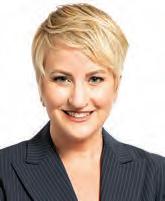
— at customs, they will see a digital welcome in their home language, depending on the flight’s origin.
“You have everything in technology from big, critical elements of the security that make sure the terminal is safe, secure and convenient for our customers, all the way to small little touches from a digital perspective,” she said. “They really create that New York sense of place and really welcome customers.”
JFK’s Terminal 4 will deploy Amadeus Auto Bag Drop, which uses biometrics to let passengers print their own bag ticket and facilitate a self-serve bag check experience.
As of April, the airport employs new and improved Credential Authentication Technology. Those touchless CAT-2 units scan passengers’ photo IDs, confirm flight information and take photos to compare an image with the ID presented. The photos get deleted upon verification by the technology and a TSA agent.
In LGA’s Terminal C, Delta Digital ID uses biometrics to allow eligible SkyMiles members to verify their identity through facial recognition and use dedicated queues. The system is part of an expanded pilot program at several airports, including JFK.

ApronAI is designed to enhance ground operations, specifically on the airport apron, where loading, unloading, refueling and boarding occur.
“It provides our operations team as well as our airlines and ground handlers more visibility and control of the whole aircraft turnaround management process, which in turn improves on-time performance,”
JFKIAT Vice President of IT and Digital Steve Tukavkin said.

Strategically placed highdefinition cameras capture events and predict performance timelines to prevent potential delays. Operators can export data out of the system, providing airlines with information like estimated arrival and departure times at the gate.
Technology can accelerate aircraft queues, too. The PA implemented an airside predictive management tool at JFK called Aerobahn, which analyzes past performance, current conditions and flight data to designate slots for planes to approach the runway. Planes use less fuel and emit less carbon when they wait at the gate instead of lining up at the taxiway.
The New Terminal One will use back-office technology to assign gates more effectively.
“The last thing you want to do is come off a 15-hour flight and be sitting on the tarmac for 45 minutes,” Aument said. “Our technology solution is a really big part of that efficient operation, which is going to drive reliability. It’s going to reduce delays when you’re on the actual aircraft, and that’s very important.”
Artificial intelligence is also finding its way into airports — Terminal 4’s operator, JFKIAT, has a new technology called ApronAI in partnership with Assaia International AG.
Asked about the future of AI in airports, Tukavkin said it might enhance passenger experience with personalized recommendations, expedite security checks and manage disruptions like delayed luggage.
“We’ve seen a lot of AI power selfserve kiosks, not only for check-in or bag drop, and we’re utilizing that technology already today, but at immigration as well to reduce wait times but also free up staff to do more complex or customer service tasks,” he said, citing the use of robots for cleaning.
The new Terminal 6 will incorporate a new Logipix Virtual Ramp Control System, with video technology and Airside Augmented Reality Solution to improve airside visibility, aid operators’ situational awareness and promote safety.
With the New Terminal One slated to open in two years, the team is in the procurement stage for operations.
“We’re procuring a lot of our technology pretty late in the program, and we’re doing this strategically,” Aument said. “Technologies are evolving very, very quickly, and so
what we want to do is be able to wait until the last moment possible ... so that when we open in June 2026, we are providing our customers and our airline partners with the absolute latest capability.”
Passengers can look forward to innovations in the air as well as on the ground.
Affectionately termed Queens’ own airline, JetBlue launched Blueprint, a personalized inflight experience platform, in April. New seatback touchscreen features include TV watch parties, personal content recommendations and meal ordering.
Last year, the PA announced a partnership with NASA to work on initiatives related to the next generation of flight in urban areas. Emerging flight technologies include the use of drones and electric vertical takeoff.
The PA held a demonstration of two electric autonomous vehicle shuttles in a platoon at the JFK Aqueduct Parking Lot in October 2022. Last year, JFK hosted an expanded demonstration of three-vehicle autonomous platooning, the first of its kind at a U.S. airport.
Platooning allows multiple autonomous vehicles to travel in unison, raising the number of passengers who can be transported simultaneously. In the future, AVs could facilitate commutes passengers would otherwise make on foot, such as to a rail station, rental car facility or parking lot.
With a mission to create opportunities for small and minority contractors, the New Terminal One partners with individuals and companies in the local community to design digital strategy.
“We’re very lucky to be here working in Queens, to be able to have access to some great local talent and to be able to have a partner in the Port Authority, and certainly colleagues here at NTO, who are doing everything we can to put that talent to work,” Aument said. Q









The idea of using water to power machinery goes back more than two millenia.
But some modern twists on the old standby soon will play a major role in meeting the city’s ever-growing appetite for energy when the Champlain Hudson Power Express line starts bringing hydroelectric power from Canada to Astoria beginning in mid-2026.
The ongoing project is a 339-mile long set of power transmission lines under contstruction by Hydro-Quebec from the New York State-Canadian border to the Con Edison campus on 20th Avenue in Astoria.
Combined with approved Clean Path New York, which will bring wind-generated power from upstate, the Equinor offshore wind project, which will bring it to the Brooklyn Marine Terminal from the Atlantic Ocean, and others, the Champlain Hudson Power express is considered a key element in meeting the state’s mandated clean energy goals for 2030 and 2050.
“Seventy percent of our electricity will come from renewables by 2030,” Gov. Hochul said in December 2022, when ground was broken for the Champlain Hudson construction in upstate Whitehall. And we used to talk about 2030 as if it’s off into the future. That’s right round the corner.”
the water.
The lines will run beneath Lake Champlain; beneath and alongside the Hudson River; down the Harlem River between Manhattan and the Bronx; across the very northern tip of Randalls Island; under the East River and into the Con Edison complex.
The company, which is the largest provider of hydroelectric energy in North America, said in a recent interview that the Champlain Hudson route will be divided about 60-40 between marine and terrestrial locations, respectively. All the lines will be buried.
Hochul’s office has said the lines will have an estimated $3.5 billion economic impact on communities along the full length of the power line, which will provide tax revenue to 73 municipalities and 59 school districts, including Nee York City.

According to Hydro-Quebec, the utility is in full construction mode, and things are progressing nicely and on schedule. Work is being done on both sides of the border.
The 35-mile Hertel line will link the U.S. side of the project with Hydro-Quebec’s vast network of more than 60 generating stations, which includes dams at massive reservoirs and socalled “run-of-river” facilities at which turbines are placed in
To handle the juice once it’s on land, TDF Blackstone, which is partnering with Hydro-Quebec, has purchased space on the Con Ed campus for construction of a converter station, work on which began back in September. The site used to house large oil storage tanks, which were removed before the land was remediated.
The station will take direct current, or DC, electricity from the CHPE and convert it into alternating current, or AC.
Not yet under construction is the network of more than three miles of underground power lines that will transport the electricity to the Rainey Substation on Vernon Boulevard in Long Island City, where Con Edison will then transmit it to customers.
According to Hydro-Quebec, improved technology both now and in the future, even should it come in increments, serves both customers and the environment in the long term.
Some of its power generation plants were built back in the

1960s, ’70s, ’80s, and ’90s, with the most recent one only a few years old. But with such a large network, the company said it is usually in the midst of some sort of renovations or upgrades somewhere in its system that improves efficiency.
Even something as seemingly small as swapping out old turbine blades for newer, advanced ones, can allow the company to generate more electricity with the same amount of water flow.
And, the company said, that while wind, solar and other options always must be part of any mix, hydroelectric has a reliability advantage, able to fill gaps when the sun isn’t shining and the wind isn’t blowing. Q
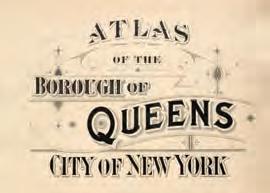






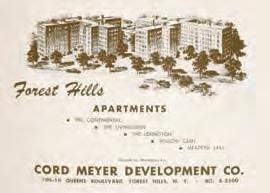

Since 1904, Cord Meyer Development has helped shape the growth of Queens. From Elmhurst, Woodside, and Forest Hills to Bayside, Bay Terrace, and beyond, the communities we developed continue to thrive and stand the test of time.
As we embark on our second 120 years of service, Cord Meyer is excited to introduce new projects that look to the borough’s future. While much has changed since 1904, our commitment to Queens remains as strong today as the day we were founded.
























Western Queens has been supplying much of New York City with electricity for more than a century.
Con Edison’s Astoria Yard property, a 316-acre parcel on 20th Avenue first acquired in 1937, has been producing energy since at least 1902. The Ravenswood generating station in Long Island City, built by Con Ed in 1963, is the largest supplier of electricity in the city and, according to its latest owner, was once the dirtiest.
But the energy sector in Queens has new players looking to bring clean energy from renewable sources to old sites in Long Island City and Astoria.
Rise Light and Power, which bought the Ravenswood station in 2017, has been decommissioning dirtier fossil-fuel generators and upgrading the ones remaining, with the aim of eventually replacing them to transition fully to renewable energy power sources. It is partnering with British and French partners on Attentive Energy One, a wind farm proposal that is going through the state approval process.
The plan is to build the turbines south of Long Island and east of the New Jersey shore.
And Con Edison, amidst more than $2 billion in investments to deliver energy from wind, solar and other sources, has begun bringing new technology to Queens and Brooklyn, bringing innovations and new uses to older technology aimed at isolating system problems and keeping them from spreading.
Clint Plummer, the CEO of Rise Light and Power, said little has changed since the company went public with its plans for Renewable Ravenswood two years ago.
“We plan to retire and replace all 1,800 megwatts of our 1960s-vintage of generation with clean-energy technology, including offshore wind and renewables from upstate,” Plummer told the Chronicle in an interview last week.

Rise Light and Power is applying for state approval to bring electricity from an offshore wind farm into its “Renewable Ravenswood” site in Long Island City. The aim is to eventually convert the entire site to renewable energy delivery.
put them out in deeper water where the blades capture more wind more efficiently than decades ago. The technology is massive. It’s huge in Europe. It’s huge in Asia. The U.S. itself is just getting started.”
Plummer said the benefits in Queens will be both environmental and economic. He said the site already is different than even five years ago.

Plummer said the company recently cleared a huge hurdle when its major permit application, submitted to the state in December 2022, was deemed complete by the state. The next step will be a set of public hearings in late July.
“Which the public from all over Queens can and should come to, to learn more about the project and share their views with the regulatory authorities who will be deciding on the permits,” Plummer said.
The basic technology, Plummer said, is more that 25 years old, but still relatively new to the United States.
“The first offshore wind facility was built off the cost of Denmark in about 1990,” he said. “And that project was only just decommissioned a few years go, so there’s a long, successful history of it. To be sure, the turbines have gotten larger and we’re able to
“First off, there was a lot more fossil generation, and it also was in a significant state of disrepair,” Plummer said. “We changed both of those things.”
He said the company has retired 17 small generators, “some of the oldest and dirtiest in all of New York City.” The four remaining large generators — think the large red-and-white smokestacks that rise above the property — were in a “significant state of disrepair, leaving them less reliable and less safe.” He said Rise has spent $200 million in site environmental and safety upgrades.
“That has paid off,” Plummer said.
If all goes according to plan, the four large generators, now helping to keep the lights on in the city, will be replaced with renewables over time.
Plummer said aside from creating new jobs, Rise plans to retrain all present workers to stay on after the full transition. The site will be the maintenance and operation center for the turbines. Offshore workers will be domiciled on the site.
“It has unique potential — to bring a very large amount of clean energy into Queens, and also the potential to bring a lot of job creation into Queens.”
And Plummer, whose resume goes back to the Block Island wind farm, the first in the
Con Ed is sophisticated enough to detect failures in the system, block them off to keep them from spreading, and notify the control center that a problem exists.
“And by placing these interrupters out in different neighborhoods in different streets and different networks, we can reduce the impact of the equipment failure by over 50 percent,” Brennan said.
Elisabeth Ferrari, media relations manager at Con Ed, said the typical customer will experience one non-storm-related outage every seven years, and that the interrupters will improve reliability.
Brennan said while the idea is not new, the interrupters have been designed to meet the specific demands of New York City.
In the years he represented Astoria in the City Council from 2014 to 2021, Costa Constantinides pushed to eliminate fossil fuel generation from what he and others long have called Asthma Alley for the high levels of respiratory illnesses and other ailments among residents, which he lays at the door of the energy industry.
Now CEO of the Variety Boys & Girls Club of Queens in Long Island City, Constantinides said the changes from Ravenswood to the Astoria Yard give him hope.
United States, said environmental reviews are the most robust in the energy industry.
“Offshore wind undergoes extensive oversight from multiple levels of government and multiple different agencies at every level of government,” he said. “And again I know this from direct experience. In the case of the Block Island wind farm, we had to obtain over 20 separate approvals, consents, permits and entitlements. And had we not received only one of those, the project would not have been able to move forward.”
He said every review includes detailed studies of fish, sharks, marine mammals, migration patterns, visual impacts and even colonies of “worms that live in the top inches of muck on the ocean floor.” He also said there have been no links established between wind and whale deaths.
“Every incident has been investigated by the National Marine Fisheries Service and other agencies, and has found that there is no direct relation with any offshore wind activity.”
And with the first dog days of summer hitting the city this week, Con Edison is on the first year of a five-year plan to place 100 “interrupters” below ground to isolate outages and keep them contained.
“An interrupter physically is similar to the circuit breaker in your house,” said James Brennan, the utility’s vice president of Brooklyn and Queens electric operations. “It interrupts current flowing through the system. But it’s been reimagined from something that exists in a large substation to something that can be placed in our underground network in a manhole or in a vault or beneath the streets and will withstand all the elements that come at it through snow, and salt, and water and extreme heat.”
“I’m optimistic,” he said. “I’m still working with all these groups, and I’m seeing a lot of progress. On the Con Edison site, you have the conversion of one station, taking fossil fuel tanks, that now is going to be a converter station for Hydro-Quebec and their project” [see separate story].
“You have the largest fossil producer in the city at Ravenswood. Clint Plummer and those guys have come in and been very clear about their desire to transform that location.”
He said BP is pursuing wind-generated energy at the old NRG plant on the Con Edison complex that ran on fossil fuel.
“I think we’re heading in the right direction,” Constantinides said. “I think we’re on the pathway toward transforming Asthma Alley to Renewable Row ... All these energy companies are making good investments in the community and in people; trying to reconcile some of the wrongs that happened because of fossil fuel production.” Q
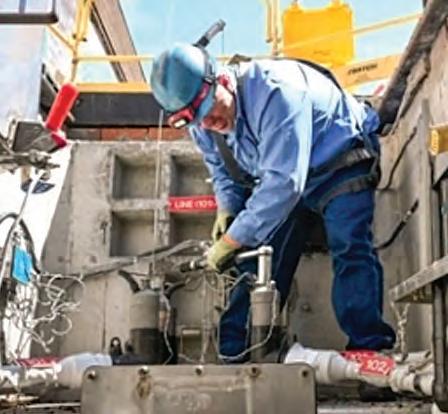
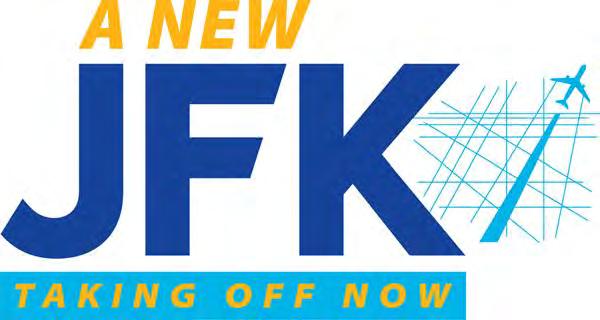

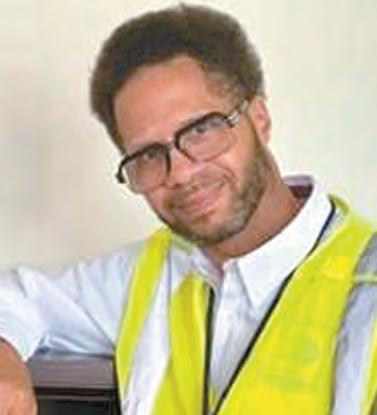
The Offi ce of Second Chance Employment (OSCE) is a job recruitment and referral program launched by the Port Authority of NY & NJ to help justice involved individuals residing in the communities surrounding the agency’s facilities get a second chance by connecting them with employment opportunities.
Launched with the strong support and encouragement by the JFK Redevelopment Community Advisory Council and managed through the Council for Airport Opportunity (CAO), the Port Authority’s primary workforce partner for its aviation facilities, the program focuses on job opportunities at John F. Kennedy International, LaGuardia, and Newark Liberty International Airports, along with other agency facilities. It has become a priority job recruitment program for the Port Authority.
CAO reviews candidate resumes and qualifi cations to best match them with suitable job openings, providing support and assistance to job seekers throughout every step in the process from referral to placement and beyond. To date, more than 170 placements have been achieved, with both Airport tenants and direct agency roles, ranging from entry level to supervisory positions. The success of the program is based upon partnerships with local, community-based re-entry organizations, such as the Fortune Society.
“At the Fortune Society, we have long recognized that gaining stable employment is one of the most critical steps toward breaking the cycle of recidivism,” said Ronald Day, Senior Vice President at The Fortune Society. “The barriers to employment for those with prior criminal legal system involvement can be formidable, but the Offi ce of Second Chances initiative by the Port Authority and the Council for Airport Opportunity is a powerful countermeasure, offering tangible career opportunities that can help individuals build a new life and contribute positively to their communities. This program represents a beacon of hope and opportunity for individuals who have faced the signifi cant challenges of reentering society after involvement in the criminal legal system. It’s about more than a second chance; it’s a pathway to lasting change.”
As the OSCE Program continues to advance, a number of its placements have stood out for their exceptional skills and work ethic. Richard Hendricks and Veronica Nieves are two such employees.
From Brooklyn, NY, Mr. Hendricks was referred to the Offi ce of Second Chance Employment by the Fortune Society for a Traffi c Attendant position with ABM. Following a successful interview, Mr. Hendricks secured the role in July 2023 and was subsequently promoted to a Traffi c Attendant Supervisor position in early 2024. In this capacity, Mr. Hendricks assists JFK Airport customers with any parking-related concerns. He
also oversees other Traffi c Attendants, providing guidance and direction on how best to service customers navigating parking and the terminal frontages.
“When given an opportunity to do good, grow, and help those in need, by any person or organization that is truly wishing you success and providing positive support, it opens up a positive and thriving future,” Mr. Hendricks said.
Joseph Tristaino, ABM Operations Manager and Supervisor to Mr. Hendricks explains, “We all have a backstory that we learn and grow from. Good strong support, Second Chance provides for the people they represent and an employer like ABM helps in creating a positive future for all!”
In addition, to his promotion earlier this year, Mr. Hendricks is also a recent recipient of the Port Authority’s We Soar Award for going above and beyond to provide an exceptional customer service experience to patrons of JFK Airport.
A native of the Bronx, Ms. Nieves, was also referred to the OSCE by the Fortune Society for a direct role with the Port Authority. Following a successful interview, Ms. Nieves was offered a position as an Assistant Human Resources Representative within the agency in 2023, where she currently remains. In this role, Ms. Nieves responsibilities include reception, scheduling, timekeeping and other general offi ce management duties.
“The Offi ce of Second Chance Employment provided me with the opportunity to interview with The Port Authority and has given me the chance to show and prove that my past decisions do not defi ne me as a person,” Ms. Nieves said of her experience with the program. “The Port Authority is a great company and I feel blessed to be a part of such a great team with an exciting future.”
As further testament to her work ethic, Nidia Abreu, Executive Business Manager and supervisor of Ms. Nieves states, “Veronica is truly exceling in her current position, and her work hasn’t gone unnoticed. Her dedication and willingness to learn go without saying. Veronica is a valuable asset to our team, and her efforts and contributions are greatly appreciated.”
The Offi ce of Second Chance Employment continues to identify and cultivate employer partnerships across Port Authority facilities, to expand the universe of job opportunities and increase the number of jobs available.
For more information on the OSCE Program, contact Denisha Rapier, OSCE Program Manager with the Council for Airport Opportunity at drapier@caony.com.
High technology brings trepidation for good reason, but there’s no denying that countless daily tasks are much simpler than they used to be. Today’s 20-somethings grew up with the web as a constant presence, something that’s always on in the supercomputers, aka smart phones, in their pockets. Many of their parents,
Generation X-ers, were in their 20s themselves 30 years ago at the dawn of the internet age. They had to leave the house to meet potential dates, pay bills by mail and use the library for research. Here’s a look at just some of the differences between the tech of everyday life in 1994 and today. — Peter C. Mastrosimone
then and now
Then: Make sure no one is on the phone, connect to the line, put up with a cacophony of electronic noise and eventually get on at 28.8 kilobits per second. You can download a picture in about 10 minutes.
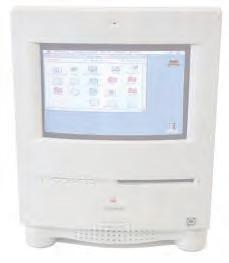
Now: Click on a track from your Spotify list or tell Alexa or Siri to do it. Maybe play a record because it’s vintage kitsch.
Then: Get your card placed in a machine with a handle that an employee forcefully moves back and forth to get the numbers imprinted on a piece of paper and carbon copy. The worker, who might get his or her skin caught in the thing, as recapped on reddit and elsewhere, also may have to call to get use of the card authorized.
Now: Go to the streaming service of your choice, find a movie and click rent or buy.

Now: Be constantly connected to your Wi-Fi and log on at instant high speed. Use cellular data if necessary.


Then: Pick a CD or cassette from the rack, put it in the home component stereo system, boombox or Walkman and press play. Maybe play a record because you still have a lot of those, too. In the car, take the stereo faceplate out with you.


Now: Swipe, tap or dip your card.
Then: Find the cordless phone receiver, hope it was in the cradle so it’s charged, push seven or 10 buttons, or, if calling someone close to you, go to the presets and choose one of the 10 or so numbers saved there. If you’re really old-school, you might still have a rotary phone.

Then: Go to Blockbuster or your independent movie rental place, pick one out and, most likely, bring the box to the register to see if they have a copy in. You may need to reserve one.


Now: Pick up your smart phone, tap the app, find the person in either your contacts or recents and tap the number. Or ask Siri or Alexa to do it.

Now: Go to your bank’s app on your phone and scroll through transactions to see if there are any surprises.

Then: Write a check, mail it and expect it to take three to five business days to clear once deposited.
Now: Have directions read aloud to you by your favorite navigation app.
Then: Go to the bank, speak to the teller, maybe one of the people with a desk, too.

Now: Open the Zelle or Venmo app, enter or click on a name, enter a dollar amount and expect it to take three to five seconds to be in the recipient’s account.
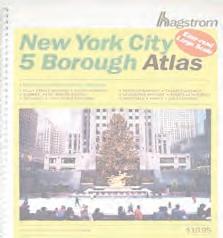
Then: Have a map on the passenger seat and try not to look at it when you should be looking ahead, but still look at it to know when you have to turn. Or have a passenger give you directions from it.
PHOTO CREDITS: 1994 MACINTOSH COLOR CLASSIC COMPUTER: MYSTÈRE MARTIN / WIKIPEDIA; COMPACT DISC: ASIER_RELAMPAGOESTUDIO / FREEPIK.COM; CASSETTE TAPE: DMITRY DEMIDOV / PEXELS.COM; CREDIT CARD MACHINE: REDDIT.COM/R/NOSTALGIA; ATT CORDLESS PHONE: PHRONTIS / WIKIPEDIA; HAGSTROM ATLAS: THRIFTBOOKS.COM; BLANK CHECK: FREEPIK.COM





There are new advancements in medical treatments thanks to the development and improvement of technology in hospitals.
These new and improved devices result in more efficient procedures, along with less recovery time and drugs such as narcotics, leading to better outcomes for people, according to several doctors of various specialities in hospitals throughout the borough.
“Here at Elmhurst we have been upgrading our large pieces of medical equipment,” Mike Milinic, the chief operating officer of NYC Health + Hospitals/Elmhurst, told the Chronicle. “A lot of them are in our radiology areas.”
The hospital used City Council funds in part to buy a GE Revolution Apex CT system, said Dr. Vivek Masson, the director of radiology.
“This is the absolute top-of-the -line CT that is available,” Masson said. “It allows us to provide the lowest possible dose to the patient with the highest-quality image.”
Masson said staff at the hospital are now able to do cardiac CTs, which allows them to scan a heart instantaneously and get very precise imaging in a short time frame.
The hospital’s neuro program is also able to utilize gemstone spectral imaging, which allows it do postthrombectomy CTs.
“This is something we were not able to do before,” Masson told the Chronicle.
A thrombectomy is a procedure that restores blood flow to the brain after a stroke.
“We are also able to utilize this for our trauma patients,” Masson said. “We are able to read the cases a lot quicker than we could do before. It’s a big timesaver.”
The hospital also has a first-of-its kind Transcranial Magnetic Stimulation clinic.
The breakthrough technology
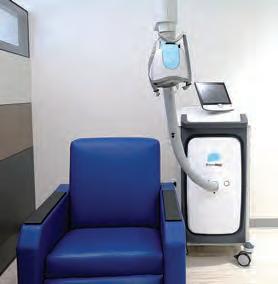
helps patients with depression in ways that talk therapy and medication might fail, said Dr. John MacKenzie, director of interventional psychiatry.
“Therapy targets patterns of thinking and medications work on on the level of what we understand of neurotransmitters,” MacKenzie said. “TMS works on the level of neurocircuitry.”
At the TMS clinic, a patient will sit on a chair wearing a helmet delivering pulse magnetic fields to stimulate specific areas of the brain that are not functioning correctly or underfunctioning under certain mental disorders for 30 daily treatments. The procedure lasts about 20 minutes.
The hospital uses the Brainsway H1 TMS system to treat patients with major depressive disorder and it has been approved to also treat people with difficulty quitting smoking and obsessive compulsive disorder.
“This is very different from other typical treatments in psychiatry,” MacKenzie told the Chronicle. “It is time limited and there is no medication to take, which eliminates a lot of stigma that patients might have in taking medication every day.”
Unlike psychiatric medications, which have intolerable side effects, TMS treatments patients might have a slight headache and go about their day immediately after the procedure.
At Long Island Jewish Forest Hills Hospital, some doctors are using the Ziehm imaging system and Stryker navigational platform.
“We are finding a way to do an operation in almost real time by acquiring images inside the operating room,” said Dr. Jaime Nieto, LIJFH’s chief of neurosurgery.
The Ziehm X-ray machine gives doctors the ability to do a CAT scan inside the operating room and the image is transferred to the Stryker Q-accuracy platform, which helps doctors during the navigation process of a surgery, said Nieto, who
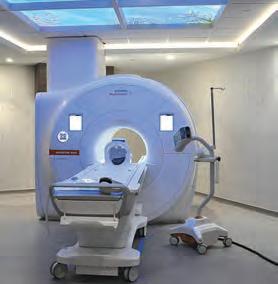

specializes in spinal surgery.
“You can essentially move around inside the patient within milimeters of certainty and accuracy,” he said. In the past, a patient would get a consultation, then go to various places to get imaging done, and once the doctor received the results a surgery was scheduled. Now there are fewer trips a person has to make for treatment.
“Now you can come to the operating room when you are ready,” Nieto said. The surgeon said he is also able to get post-op imaging scans, so as soon as a surgery is done he can check if everything is in place immediately.
“In the past, [the postop scan] would be the next day or after the surgery,” Nieto said. “Now we can do it even before we close the surgery.”
Dr. Sandeep Anantha is LIJFH’s director of surgical oncology, who treats patients with gastrointestinal cancers (pancreatic, liver and bile duct cancers, to a name a few), very aggressive forms of the disease.
mally invasive techniques for some of the complex procedures, said Anantha.
“The da Vinci robot allows us to push the envelope in performing complex surgeries in a minimally invasive way,” he said. “Some of the complex maneuvers are limited by laparoscopy ... That limits certain complex surgeries in difficult places to reach.”
The maneuverability and 3D visualization of the da Vinci robot allows for smaller incisions, less pain for patients and faster recovery times.
“Robotic surgery offers patients the ability to have smaller incisions with better pain control and earlier return to baseline functional activity,” Anantha said.

Dr. Hazem Shoirah, director of thrombectomy services at Mount Sinai Queens in Long Island City, is using Viz.ai, an AI tool that helps with interpreting CT and CTA scans instantly.
“What we have at Forest Hills is the da Vinci robot,” said Anantha. “It’s the pinnacle of surgical technology at this point for minimally invasive surgeries that can be performed ... I honestly believe that is the emerging technology that is accessible to Queens [residents] that allows them to seek the best cancer care they can get.”
The conventional way of treating cancer is open surgery, and the advent of robotic surgery allows patients to reap the benefits of mini-
“This technology uses AI and Q-learning modules to rapidly interpret CTA images of patients who are suffering from stroke symptoms,” Shoirah said. “Within those images, we can identify if there is a blockage or an occlusion of a large vessel in a matter of seconds.”
If the tool identifies a patient as having a large-vessel occlusion stroke, the worse type, it will automatically send out an activiation alert to all of the treatment team members who are involved in the surgeries that would help restore blood flow to the patient, he said.
“That technology can help quick-
ly diagnosis patients with large-vessel occlusion strokes but also get them on the path to surgery faster and opening vessels faster and to get them into recovery faster,” Shoirah said.
Jamaica Hospital Medical Center recently purchased two different Tesla MRI machines, according to Dr. Musa Mufti, director of musculoskeletal intervention at both Jamaica and Flushing hospital medical centers.
“We are using those magnets to improve our patients experience,” said Mufti. “It improves our image quality and our scan times.”
With shorter schedule and wait scan times, patients get out of the hospital quicker, Mufti said.
“The scan times have dramatically decreased and we are able to perform newer sequences that allow us to characterize scans in greater detail, which can give our surgeons and physicians more insight into what potential pathologies they are dealing with and improve the treatments we can offer our patients,” he said. “We can be more definitive about the diagnosis we are reaching.”
Dr. Seth Goldberg, director of cardiac electrophysiology at NewYork-Presbyterian Queens in Flushing, helped to lead a trial introducing AI into the treatment of atrial fibrillation.
The conclusion from the trial was positive and the procedure is being used at the hospital. AFib is a heart rhythm disorder that causes fatigue, dizziness, anxiety and more.
The AI treatment identifies critical areas for minimally invasive catheter-based procedures, said a spokesperson for the hospital. Q























Today’s students are sowing the seeds of the future — literally and figuratively. From hydroponic gardens flourishing in school classrooms to robotics teams crafting tomorrow’s technology today, young minds in Queens are not just hitting the books: They’re cultivating futuristic gardens and engineering robots.
In recent years, hydroponics labs have started to pop up in schools. NY Sun Works already has 48 hydroponics classrooms in Queens — with 22 more set to open this year.
Hydroponics is a growing method that uses mineral-based nutrient solutions to nourish plants without soil. The labs, built in partnership with New York Sun Works, a nonprofit that built the first hydroponics classroom in 2010, give students a hands-on agricultural experience.
“Basically, you have a reservoir with water where you add the nutrients,” said Manuela Zamora, the executive director at NY Sun Works. “The water goes up through a pipe and the use of a pump to what is called an NFT, nutrient film technique, which has several gutters that are going to hold the plants.”
The nutrient film technique is a hydroponic method in which plants stand in a shallow stream of water containing nutrients. The water flow is circulated through growth tanks containing the roots of the plants, which absorb the nutrients, as well as oxygen. It’s important to check that there are enough nutrients and that pH levels are at the range necessary for the specific plants being grown.
“You use 90 percent less water than traditional farming because you’re reusing the same water that is in this specific tank,” Zamora said. She noted the size of the vessel will
vary based on the size of the system and number of plants.
“It can become more complex in the design of the actual system,” Zamora said. “You can design a system to be horizontal, that looks like a table with channels. But then you can design systems that are vertical. That’s when the innovation comes — not only to use the space better, but also to produce as much food as you can.”
Another hydroponics setup is called the vine crop or bucket system, in which fruits are grown on vines hung vertically to maximize the growing space.
Students are enjoying learning about the modern growth method, Zamora said. They become interested in the techniques used and the systems, and are learning more about healthy produce.
“They love it,” she said. “Not only growing the plants themselves, but also learning so many science connections and the understanding that comes with it. They know how much work it is to grow food, but also how tasty it is when you harvest it fresh.”
“This is a wonderful way to learn hands-on and project-based science, and understand torrents of agriculture and the direct correlation of human impact on the environment,” Zamora said.
As with a lot of technology, maintenance is required on the hydroponics systems to ensure everything is in working order.
“We usually go once a week for two hours,” Zamora said. “We stop by, check on all the systems, touch base with the teacher, mentor in any aspects that the teacher may need support on — but this is after an initial comprehensive training the teachers go through. ... The support allows for the teacher to focus on teaching, and we take care of trou-


bleshooting and other aspects that may be needed.”
Hydroponics can also be an option for innovative types who want to grow their own produce. Supplies for home hydroponic systems can be found online, via Amazon or other garden suppliers.
While some students germinate seeds and measure pH levels, some engage in more programming-oriented technology.
Robotics is a sub-domain of engineering and science that involves design, construction, operation and use of robots and computers.
In schools, students in robotics clubs actively engage in programming, computer science and engineering. Teams in schools all over the country aim to compete in the international high school FIRST Robotics Competition and others.
at the New York regional and won the Gracious Professionalism award.
For Redhawk, the work is separated into three subgroups, as explained by Giankyle Vallarta, the team’s captain, and team members Gabriel Hova and Michael Carcamo.
“We divide it into programming, manufacturing and documentation,” said Carcamo, the lead on the programming squad.
The programming group focuses on coding aspects, dealing with logic and data, complex languages and debugging errors.

In Flushing, the Overclock Robotics Middle School and High School robotics teams recently won Vex Robotics’ New York State Southern Championship and represented the state at the Vex Robotics World Championship in Dallas on April 25.
And Long Island City’s RoboTigers, based out of Queens Technical High School, this year won three regional FIRST competitions: Hudson Valley, Tech Valley and NYC.
Redhawk Robotics, the team from Ozone Park’s High School for Construction, Trades, Engineering and Architecture, placed 19th out of 51
“Programming has a division called electronics. They’re actually like the nervous system of our team,” Carcamo said. “Essentially, they are the people who actually make the brain think.” The electronics division writes code for the robot to do certain things, autonomously or otherwise.
The manufacturing team works for months to create designs for the robots by drawing — and then gets to work assembling them, taking care of wiring and assembling skeletons. The documentation team, on the other hand, does not interact with the robot itself, but handles events and outreach.
Asked what software they use to make the robots, they said it’s a combination of Java, a programming language designed to have as few implementation dependencies as possible; Visual Studio Code, a
source-code editor; and an extension called WPILib, a software library for FIRST Robotics Competition builds.
The team also uses software called AdvantageKit and AdvantageScope. The former helps the students understand what may be wrong with the robot or code, and highlights power usage and lag, while the latter graphs out the information.
Asked what the team worked on recently, Vallarta said they were focused on this year’s FIRST Robotics Competition game, Crescendo.
“The game for this year was to shoot a 12-inch diameter disc into a game object, which is called the Speaker,” he said. “It’s a [three versus three] alongside random other high schools around the city.”
The trio, who are graduating seniors and hope to pursue tech careers, said the best way to keep up with new robotics innovations is through the community. On a website called Chief Delphi, roboticsfocused minds discuss new products and issues teams are facing with their builds. The app Discord allows people to form groups with others with similar interests and stay in contact.
Whether maintaining water nutrient levels or wiring robots to do tasks, today’s students are embracing technology and are poised to pave the way for innovation. The young pioneers are not only learning about cutting-edge technology — they’re creating it, transforming their schools into launchpads for tomorrow’s breakthroughs.
Students in Queens and beyond became extra acquainted with technology in 2020, when the Covid pandemic forced schools to turn to virtual learning. Classrooms gathered remotely, via software such as Zoom or Google Meet, changing the scope of educational instruction.
Now, in 2024, though class is in session, digital learning is seemingly here to stay. The city schools chief, Chancellor David Banks, even said so himself at a town hall back in March.
While colleges have long offered online classes, the share of virtual and hybrid — half online, half in-person — courses there and in other schools has increased in the post-pandemic world.
The Department of Education has encouraged remote learning as a viable alternative when it comes to accessibility and keeping class sizes in accordance with a state mandate.
DOE First Deputy Chancellor Dan Weisberg in a statement said virtual learning benefits include flexibility with timing and location, access to diverse and accelerated coursework and aiding students who need special accommodations.
As with all changes, there are some growing pains. When the DOE decided to nix a snow day in February in favor of virtual learning, the agency hit a speed bump when staff and students had issues logging onto the online portal.
synchronous, asynchronous or a combination of both. In asynchronous learning, children participate in lessons during a time they choose. Classes might look like pre-recorded videos, a selection of materials for students to read or online discussion boards with classmates. In synchronous learning, students participate in lessons with their teacher and classmates during a scheduled time using video cameras.
In addition to learning virtually, students can participate in online therapy through a free program called NYC Teenspace. Offered by the city Health Department, the program connects teens ages 13 to 17 with a licensed therapist, regardless of school, income or insurance status. Anyone who turns 18 while enrolled can continue with the therapist until June 30 of the following year, according to nyc.gov. Those who choose to continue can pay with insurance or out-of-pocket.

But now, the DOE is determined to make it work. There are comprehensive guides on the agency’s website to all aspects of virtual learning, including how to access classes, what software to use, how to get a device if needed and how to contact staff and tech support. And on June 6, while students had a day off, they were given the option of logging online as a practice exercise to aid the agency in ensuring it is prepared for future online shifts.
There are three methods of instruction for remote learning:



Valerie Nunez, an educator from Whitestone who graduated college during Covid, said she enjoys both learning and teaching virtually.
“Maybe it’s because I was a pandemic-era student,” she said. “But I loved online classes.”
Nunez said students, especially younger kids, are learning to navigate the internet and computers more in depth because of it.
“Let’s be honest, children are already spending time looking at TV screens and iPads,” she said. “But now, some are engaging in lessons on computers. Virtual learning is like taking a hybrid computer class combined with regular academics, like English Language Arts or math.”
Nunez also said the instruction method helps reading comprehension for younger students who may be struggling.
“They have to read the icons and buttons on the screen and on their devices,” she said. “These students, by being on computers often, are going to become interested in how they work. They’ll want to learn to code or maybe even build them.”





One Kew Gardens parent said she hopes virtual learning becomes more common.
“My son is a type 1 diabetic,” Bianca W., a finance analyst based in Long Island City, told the Chronicle. “Online classes are a great idea for kids with a condition like his. They would ensure better attendance and comprehension, since he won’t be distracted while in school feeling lightheaded, and won’t distract other students if he needs to eat or adjust his insulin.”
She added, “I feel like this is a logical shift, pivoting to online school — at least some of the time. Technology is advancing in everything, even in my career. Look around. And I believe online school will help kids and education evolve with the landscape of the future instead of falling behind.” Q






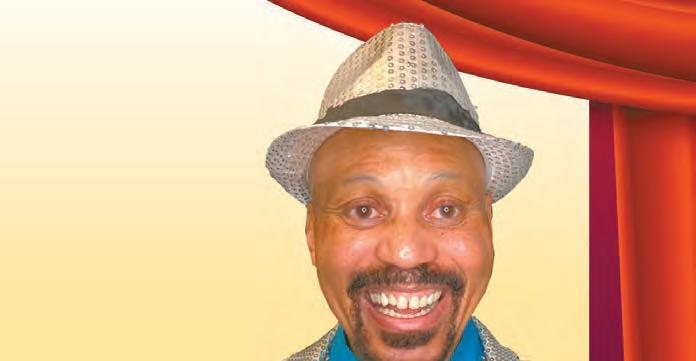

“I love technology in the theater,” said Angel Gil Orrios, executive and artistic director of the borough’s fabled Thalia Spanish Theatre in Sunnyside.
“I’ve been innovating for a long time,” he added in a recent telephone interview, explaining that he “revolutionized the way we see things.”
He was referring to a Flamenco musical adapted from a littleknown surrealistic play by the Spanish painter, Pablo Picasso, “Desire Caught by the Tail,” in which Gil Orrios replaced traditional lighting with slide projections.
In the show, which he staged in 1988, long before projections became as ubiquitous as they are today, he projected no fewer than 150 of the artist’s works. In collaboration with a computer expert, and with the use of a three-dimensional white cube on stage, Gil Orrios said he was able to give the effect of the paintings being three dimensional.
He has used technology “a lot” since then, he said, including supertitles, which “eliminate barriers of language” and allow “American audiences to see wonderful plays” by Hispanic writers, who are often represented at the theater with plays in their original language.
He said his staging style is “total theater,” a synthesis of the arts: performing arts, audiovisual arts and fine arts.
One of the attractions Gil Orrios most looks forward to is a production of “The Painter and the Model,” a musical he is writing that was inspired by the life of Picasso. It will include the use of holograms, and Gil Orrios promised it will be “total theater of the senses.”
The Thalia is one of several theaters across the borough that incorporate technology — to a greater or

lesser extent.
Take, for example, the Queensborough Performing Arts Center on the campus of Queensborough Community College in Bayside, which recently underwent a fouryear, $15 million overhaul, with an eye toward modernizing various aspects of the facility, including its technological capabilities.
“Since the theater went into operation some 50 years ago, the technology used has evolved dramatically,” said Executive and Artistic Director Susan Agin in an email response to the Chronicle. “More importantly are the expectations of the audience. Their viewing and listening levels have grown and they expect a heightened experience.”
With the audience in mind, the theater purchased a “robust and powerful lighting package of environmentally friendly instrumens ... that provide spectacular control and illumination,” Agin said.
The theater has moved from incandescent lighting to the ecofriendlier LED lighting, which, Agin explained, “helped reduce the carbon footprint that was a by-product of our older theater lighting.”
The new technology offers enhanced quality, greater energy efficiency, and extended durability.
Another area that has been improved at QPAC is sound. The new system “allows every seat in the house to experience clear dialogue and well-developed sound for both live and recorded music,”
Agin said.
And QPAC has not overlooked its abilities to use projections. Whereas in the past projections would often be washed out by the stage lights, with “such sophisticated equipment it is no longer an issue,” according to Agin. And, she added, “We don’t have to find ways around achieving the look we want.”
Jan Yanofsky, director of Kupfer-



berg Center for the Arts on the campus of Queens College in Flushing, indicated in a recent telephone interview that Colden Auditorium, the center’s crown jewel, is converting to all-LED lighting, with the second phase of an update pushed back until next year.
He indicated that the center is “in the process of purchasing an LED wall,” a screen that forms a highresolution display that can act as a versatile canvas for use in theatrical presentations.
It will “dramatically improve the look and feel of some touring shows,” which frequently play the venue, Yanofsky said. He promised “inhouse capabilities that will be industry leading.”
Also in the planning stage is an upgrade to the theater’s sound system.
some set building,” a reference to the more traditional way of creating an on-stage environment.
His theater is in the process of switching from incandescent to LED lighting, which, in addition to its other attributes, provides greater illumination and generates less heat, Clay explained.

Already completed is what Yanofsky called a “major HVAC replacement project.” The upgrade involved repairing or replacing the old HVAC system, which is now in compliance with modern standards of climate control and energy efficiency, Yanofsky said.
“I embrace technology where it can support live performances,” he said, while cautioning that people who work in the theater “should never be at the mercy of technology.”
When it comes to relying on technology, Carl Clay, founder and executive producer of Black Spectrum Theatre in Jamaica, is also semi-sold on the idea, particularly when it comes to projections,
“It’s not one size fits all,” Clay said. “It’s interesting in some cases to use projections. Some shows it can work for and others not. This season we did some projections and
“It’s a whole new type of lighting,” he said, adding that the theater is converting from analog lighting boards, which require manual controls and offer only fixed lighting positions, to digital lighting boards, which allow for precise control of each lighting fixture and more complex lighting effects. In addition, the updated technology means the lighting schemes for a greater number of shows can be stored simultaneously, according to Clay.
The sound department at BST still uses MP4 recorders, but according to Clay, “We can now add different apps to do different things” in this area.
The founder and artistic director of The Secret Theatre in Woodside, Richard Mazda, is “generally really happy” about the use of technology, citing several examples of recent Broadway shows that have put it to great use.
“Technology is really helpful,” he said in a recent telephone interview, even at smaller venues like his. In a production there of “A Christmas Carol,” Mazda said he was able to fire off multiple smoke machines simultaneously thanks to creative use of technology.
The theater also has the capability to synchronize lights to music. In the past, such a seemingly simple task had to be handled manually. Now, it’s done with a computer.
Like some of his fellow theater directors, Mazda said projections can “really work, but it depends on the show. It needs to be done in such a way that it doesn’t overwhelm the artists on stage.
“Generally, I’m pro-tech, but it can be a double-edged sword.”
Treating technology as a medium of art unto itself is Cosette Pin, a video and sound designer who recently worked on the world premiere of “Third Law,” an interactive theatrical experience. It was produced at Culture Lab in Long Island City along with What Will the Neighbors Say?, a theater company that endeavors to employ “expressive designs that confront and arouse.”
In fact, the company’s website indicates that it tries to bring the audience “into the heart of artmaking using technology.”
In an email response, Pin said, “‘Third Law’ is a perfect example of what can be created when the art of design is embraced and used as the driving force and the beating heart of theatrical immersion.”
The production incorporated an “interactable gameboard that requires audience cooperation to function, quite literally centering it in the space and allowing that mechanic to breathe with the audience as we begin to see patterns emerge.”
According to Pin, “What you are left with is a fundamentally human machine that leans into technology as a medium of art and, ultimately, tangible human connection.”
The machine that was devised specifically for the show was “incredibly innovative,” Pin said, adding that the technology employed was such an integral part of it that it “cannot be removed from the artistic intent of the piece.” Q
INC.
P.O. BOX 340998
ROCHDALE VILLAGE, NEW YORK 11434-3404

Barbara DeYounge-Ezell, President
Carolyn Sheppard, Vice President GENERAL MEMBERSHIP MEETING
ST. Catherine of Sienna Church Hall 118-22 Riverton Street (Off Baisley Boulevard) St. Albans, New York 11434
Time: 7:00 P.M.
EVERY SECOND THURSDAY OF THE MONTH
ON RECESS: JULY & AUGUST RESUME: SEPTEMBER - JUNE COME OUT AND JOIN US!
Early in the year of 1977, leaders and neighbors met to discuss the need of a civic organization in this neighborhood. One such neighbor, Mrs. Delois Eason served as a Community Organizer for the Octagon Civic Association. The streets that fell within the organization boundaries were; Eveleth Road, Zoller Road, Anderson Road, Selover Road, Leslie Road, Sidway Place, 178th Place and 180th Street. Mrs. Eason named the eight streets, “The Octagon Neighborhood Association” with TONA as the logo. Later on, three more blocks were added: Irwin Place, Troutville Rd, Ursina Rd. Sunbury Rd. We appreciate the hard work and efforts put in to keep TONA alive. A special thank you to Mr. Elmer H. Blackburne, principal founder of the civic, and Lester (former President) for their dedication to the Civic over the years and their continued support.
Through the years, The Octagon Civic Association, Inc. have been advocates for Quality of Life in our neighborhood. We managed to stop the opening of a Slaughter house on Farmers & Merrick and we continue to do so today.
Since 1977 we have been trying to increase our membership, by introducing new home owners and renters to our civic in hopes that they will join.
We did not meet during the Covid Epidemic, but continued to call 311 to complain about crime in our neighborhood.










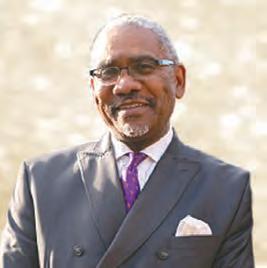















As we inevitably age, technology can help make everything from walking to gardening easier. It can give people their hearing back. It can be as simple as new shapes, surfaces and materials for technology as old as the first tree branch ever used as a cane, or high-tech medical devices that can save a person’s life.
For Neil Black of Glen Oaks, a hearing aid gave him back what most take for granted.
“Over the years, I lost a lot of my hearing,” Black said. “When I was in college, all of us used to go to these rock shows. We didn’t know of stuff like earplugs. I think it affected all our hearing. And it reached the point where I was losing the ability to speak with my grandchildren, my great nephews and nieces, because children can speak very softy. One day I got up and told my significant other that it was time to do something about this.”
After shopping around and making an unpleasant stop or two elsewhere, he went to a MiracleEar location in Bayside. He was impressed by his reception even before they determined his income level qualified him for free hearing aids from the Miracle-Ear Foundation.
Perhaps less well-known are continuous positive airway pressure, or CPAP, machines, which assist breathing for people with sleep apnea via use of masks. CPAP machines can improve health — and with new technological advances, also can provide useful or potentially life-saving information to patients with more complicated medical conditions.
Sleep apnea is a condition in which people can stop breathing one or more times, often many, during the night. A system manufactured by ResMed of San Diego, for example, assists with breathing pressure to reduce apnea.
But it also allows a user to look at his or her cell phone in the morning and get immediate feedback on things such as how long the mask was in use the night before; how many apnea events occurred per hour the night before; if there were leaks in the seal during the night, perhaps requiring adjustments of the mask or the wearer’s behavior; and even compilations for weeks or months of information.

Black recently attended a function in Philadelphia where Miracle-Ear offered free hearing tests, and also provided free devices to those whose income levels qualified them.
“Some people have to adjust to them, but for me it was like I never missed anything. Now I can hear my grandchildren speak.” And if they are at a large gathering and he needs the volume adjusted up or down?
“My wife can do it from her phone,” Black said. “We have hand signals.”
The best hearing aids now connect to smart phones and car audio systems via Bluetooth.

The numbers can tell where all seems to be well or give an informed patient signs that might need immediate attention. They also can send the information to a patient’s doctor.
The website seniorhealthpa.com lists a number of areas where technology for seniors is improving, such as mobility devices; screen readers on phones, tablets and computers for those with impaired vision; memory assistance apps; ergonomic kitchen tools; and communication aids for mobile phones.
Barry Klitsberg, president of the Queens Interagency Council on the Aging, said many changes to technology for seniors are a natural evolution.
“Many of them come from improvements to existing technology,” he said. “We look at them and say, ‘Why didn’t we think of that before?’” He also said more seniors are already more
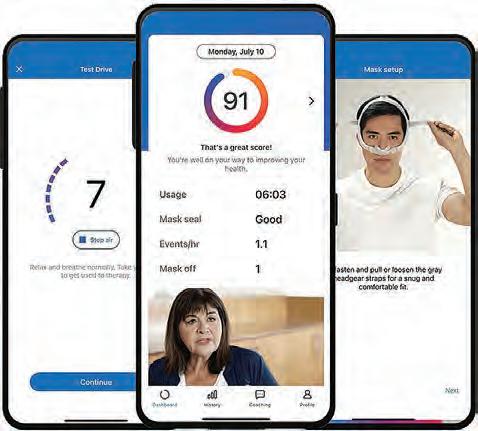
Some medical devices, from hearing aids to breathing machines, can now be connected to cell phones. Above, the MyAir app that goes with CPAP machines. RESMED IMAGE
tech-savvy than those who retired 30 years ago.
“Ten thousand baby boomers are turning 65 every day,” Klitsberg said. “They’ve probably at least used computers at work.”
But he also said there is a dark side, such as technology making it easier to scam or con unsuspecting seniors through legitimate-sounding ways.
“People can lose tens of thousands of dollars because they meet someone nice online and give out personal information — particularly someone who is isolated.” Q








Jamaica Hospital Medical Center is proud to be named one of America’s 100 Best Hospitals by Healthgrades























Serving our patients and the community in a way that is second to none

























It’s not just you — there has been an increasing number of electric vehicles around the World’s Borough, as well as citywide, in the last few years.
According to the city’s Department of Transportation, in just May 2023, the city accounted for 21 percent of EV ownership across the state. As of early June, that number has gone up to 27 percent.
As of May 2024, Queens led the five boroughs in electric vehicle ownership, with residents here accounting for 26,855 of the city’s 59,293, or about 45 percent, the DOT said.
The popularity comes at a time when electric vehicle charging stations also are becoming increasingly widespread. Just this February, Queens became home to the city’s largest residential EV charging site as Con Edison helped fund 423 chargers at the Hilltop Village Co-Op in Hollis Hills. A map on the DOT website shows approximately 75 Queens locations where residents can charge their EVs, each with a varying amount of plugs and types of them — different chargers fill up car batteries faster than others.
ing. Level 2 chargers, on the other hand, are typically used to charge overnight. Queens has 330 individual Level 2 chargers, the DOT said. Though the agency intends to build eight more fast-charging hubs in Queens through a partnership with the New York Power Authority, it is not clear when that will happen.
But the level of charger availability is changing as the city’s own fleet moves toward being fully electric, which Mayor Adams has pledged to largely do by 2035, with emergency vehicles and heavy-duty trucks included by 2038. According to Keith Kerman, deputy commissioner of the Department of City Administrative Services and the city’s firstever chief fleet officer, over 5,100 of the some 28,000 vehicles in the city’s fleet are electric at this point, or more than 18 percent.

But only 13 Queens sites have the fastest chargers, called Level 3 chargers, per the DOT. Those plugs can fill up an EV battery at a rate of 30 miles of range per 10 minutes of charg-
That does not mean, however, that the city is blowing through thousands of dollars on Teslas. (Actually, none of the city’s electric fleet vehicles are Teslas.) Kerman said the Chevy Bolt is the most common EV the city uses, and that, with 1,100 and counting, New York City has the country’s largest Bolt fleet. In fact, he added, Chevrolet had previously planned to discontinue the Bolt, “which we were not a happy group about, and we expressed that.” Chevy has since announced it would and has suspended Bolt production for two years and will release the next generation for the 2025

• Five-Star Nursing & Rehabilitation Facility awarded by the Centers for Medicare and Medicaid Services.
• Administrator member of American College of Health Administrators
• Administrator recipient of CMS Outstanding Achievement award for Reducing Hospitalizations

model year. Among the other EVs included in the city’s fleet are the Ford Mustang Mach-E, the Ford Transit, the Ford F-150 Lightning and the Nissan Leaf.
To accommodate that fleet, DCAS has installed 2,043 chargers citywide. Of those 2,043, 688, or 34 percent, are in Queens. Two hundred ninety-seven of those 2,043 are fast chargers, 81 of them in Queens, Kerman said.
Among those are the five Level 3 chargers installed in Flushing Meadows Corona Park at the World’s Fair Marina in February, on top of the two free-standing, Level 2 ones put there

previously, which are solar powered and separate from the electric grid. Kerman said the site has been very popular, both for charging fleet vehicles and residents’ own EVs.
“There are lines constantly — we’ve got to work on getting more over there,” he said. He added that DCAS has installed 44 free-standing chargers in the World’s Borough to date. Meanwhile, the DOT has worked with Con Ed on a curbside charging pilot programs, with 18 Level 2 plugs across seven sites in Queens.
The next frontier for Kerman and the city’s fleet will be moving toward electrically powered, heavy-duty trucks. But is the technology there just yet?
“Even three years ago, I would have told you we did not have an all-electric pickup or van in the whole city fleet ... Today, we operate more than 500, and, we have a whole new delivery showing up. So we’ve seen enormous progress in that sector in a very short amount of time,” Kerman said. “It’s totally true that a lot of the specialized equipment — the fire engines, the snow melters, the agricultural tractors, the sanitation trucks — we have limitations in the market today.” There has been some movement, though; the Department of Sanitation has seven electric garbage trucks citywide, Kerman said. The real challenge, he said, will be emergency vehicles, like snowplows and fire trucks, which need to be operable during power outages.
Visit nyserda.nys.gov to find EV chargers near you. Q



• Administrator is 2016 Recipient of Lily Leadership Award























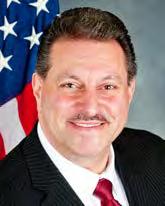

738-1111 addabbo@nysenate.gov
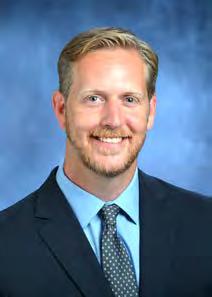




A.D.
Austin Street, Suite 118
Hills, NY 11375 Phone: (718) 263-5595
E-mail: hevesia@nyassembly.gov
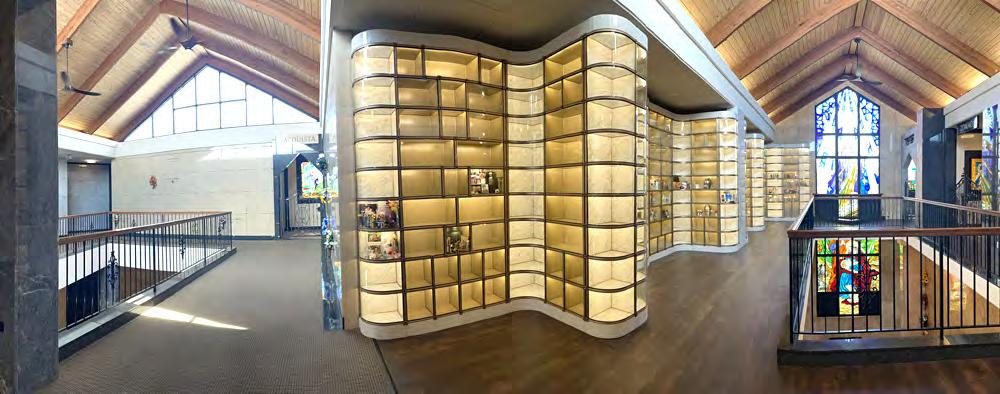
In 2024, it is trite to say that technology is a ubiquitous force in our society. Most of us know this to be true, obvious even. Still, the pervasive seep of technology into our lives has gone so far that it has become invisible to us — we take for granted the new forms of automation and machinery that we use daily. For this story, the Queens Chronicle peels back a layer of our forgetfulness and listens to five individuals working in different sectors on how they are using technology to push their work to the furthest extent possible. From still art and animation to electricity and healthcare, and even within the tech industry itself, this is how technology shapes the various sectors of our lives.
Norma Homberg, an exhibition coordinator who sits on the board of Long Island City Artists and manages its space at The Factory LIC, has been working with high school students from the Robert F. Wagner Jr. Secondary School for Arts and Technology on a digital art exhibition. The exhibit, which runs through June 25 at the LIC-A Art Space at The Factory LIC, is titled “Digitizing Fine Print” and features pieces ranging from digital drawings, portraits and cityscapes to works in more traditional mediums such as watercolor, pastels and charcoal. According to Homberg, students today are much more comfortable using a computer than others she’s seen during her seven-year tenure at LIC-A.
“[Digital art] is just a different form of art,” Homberg said. “You have to keep with the times, no matter what career you choose ... Most kids actually have computers and if they don’t, schools provide them, which is good. That’s not really a barrier anymore. ”
Homberg said she’s seen various artists at LIC-A use technology in

compelling ways, Sandra Vucicevic, Mafe Izaguirre and Caroline Voagen Nelson being some examples. In “Her Vote,” a piece celebrating the 100th anniversary of the 19th Amendment, Voagen Nelson animates still portraits of famous suffragettes such as Ida B. Wells and Lucy Burns and projects them onto hanging clotheslines in the LIC-A space.
The animation, shown at LIC-A in 2020, brings new life to the old photographs, but also connects our present era to the early 20th century, a turbulent time filled with war but also advancements in radio, film and incremental societal equality.
According to Homberg, artworks with strong technological components can make for creative and interesting pieces as long as there is still a human component to them.
“I think technology, as long as there is a human touch attached to it, is really beautiful and can do incredible things,” Homberg said.
Cosette Pin, an artist who primarily works with stage production but also does woodworking and photography, said that tech can open up new possibilities for creators.
letic trainer, said she uses the Oura Ring in her practice to give greater insight into what her patients are doing outside of their training hours. The Oura Ring is a fitness tracker, but not your typical one. Instead, it looks like a regular piece of jewelry, something Omishore says is perfect for her elderly patients who might find other fitness trackers bulky or inhibiting for daily activities.
“You can put it on like your wedding ring and forget it,” Omishore said. “With the Oura Ring on throughout the day, even when they’re not with us, we can see ‘Hey, you didn’t walk much yesterday,’ or ‘I see that you only slept three and a half hours last night.’”
Omishore is pioneering a mobile physical therapist business called TheraMotive. TheraMotive is a van, or a mobile unit, packed with physical therapy equipment so that Omishore and her team can travel to places like elder care facilities or offices where there is more room than someone’s NYC apartment.

According to Pin, most artists, woodworkers in particular, rely on some form of technology unless they’re using ancient or primitive tools.
For the most part, Pin said, technology shouldn’t be shied away from but instead embraced as something that can benefit artists.
“There was probably a point in which electric lighting became the norm, and everybody was concerned as to what that would take away from candlelit things,” Pin said. “You’re just adding more colors to the box of crayons, you’re adding more to your toolbox of what you can use to achieve a desired effect.”
Outside of the creative space, technology can aid healthcare workers to better care for their patients.
Lola Omishore, a doctor of physical therapy, orthopedic trainer and ath-
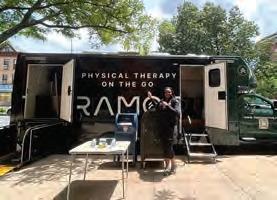

“Most people in New York, they just don’t have the luxury of building a space only for them to do physical therapy. I’m limited to a person’s couch or bed,” Omishore said. “That is just not ideal for true outcomes if somebody’s looking to improve their function.”
With TheraMotive, Omishore said she is trying to reach more patients than she could before. The mobile unit will continue expanding service this summer, and Omishore said she wants to eventually have five TheraMotive units, one for each borough.
Her practice incorporates artificial intelligence so that clients can get real-time feedback as they exercise on how to improve their form.
According to Omishore, physical therapy is a field that needs disruption and new forms of operating — and technology can play a large part in that.
“New can be intimidating, but try new things and don’t immediately turn things down because you want to stick with the tried and true,” Omishore said. “Even though something is new today, 100 years from now, it could be the status quo.”
Technology can revolutionize the way that centuries-old companies do work. Con Edison, founded in 1823, revolutionized its electricity practice with the Smart Meters that debuted in 2017. According to the utility’s website, the meter relies on low-frequency radio signals, much like
those in TVs, radios, phones and computers, to transmit user data to Con Ed’s database. Allan Drury, corporate affairs manager for the company, said the Smart Meter sends a customer’s electricity data directly to Con Ed, which allows the company to adjust a customer’s voltage and produce an automatic bill without sending a technician to read electricity usage.
“Someone would come each month and read your meter,” Drury said during a phone interview. “Now we don’t have to do that. There’s an environmental benefit, too, because that’s fewer trucks going out.”
Though the Smart Meter is more efficient for Con Ed than the previous system, Drury said the most important thing to the company is how it benefits consumers.
“Our smart meters transform the customer experience by giving our customers more insight into their energy usage. That makes it easier for customers to manage their usage to save money on their bills and reduce emissions,” Drury said via email. “Customers can see their usage in near real time and set up alerts to let them know when their usage is running high in a given billing cycle. For instance, a customer’s usage pattern may indicate that the customer would benefit by replacing an aging refrigerator or getting solar panels.”
sionals use their own tools to make their sector safer and more efficient. ETech7, an IT company with offices in Manhattan, Queens and Long Island, helps companies organize their data and cloud storage, protect themselves from cybersecurity threats and create an electronic technology infrastructure.
According to Emil Isanov, founder and CEO of ETech7, the company is releasing AI Autopilot, software built off of technology pioneered by ChatGBT that allows IT companies to automatically create tickets for new clients.

“The idea is that ticketing requires a person to sit in our office, there are tickets reported by our clients, [the dispatcher] calls our office and they record a ticket. The dispatcher, he has to, first of all, categorize the ticket that belongs to this category, he has to identify the priority, how important it is, assign it to the right team, and then he has to schedule it on their calendar. So we’ve automated all that,” Isanov said.
Isanov said that AI Autopilot reduces inefficiency and is tailored for IT professionals; ETech7 is speaking with prospective clients interested in using it. As for the needs of his current clients, Isanov said cybersecurity has become an increasing priority for many businesses.
The company has now installed almost five million Smart Meters in its coverage areas, though customers are also welcome to opt out of the program and use a traditional meter reading system instead.
Inside the tech world itself, profes-
“Cybersecurity is really important because there are sophisticated threats out there to steal your information, to steal your money and find ways to exploit weaknesses. That’s a big demand in our field right now,” Isanov said. Q
Tech in Queens is booming. There’s no other way to describe it. With the borough’s rich diversity, transportation infrastructure, world-class colleges and universities, and thriving arts and culture scene, Queens is uniquely positioned to serve as the hub for tech innovation.
The importance of tech cannot be overstated. In and of itself, the tech sector is a source for good-paying jobs, giving the smart kids who grew up and went to school here a reason to stay and live, work and play in Queens. Tech is also reshaping the way businesses across various sectors operate. This is not only transforming traditional business models, but also fostering innovation and efficiency.
The Queens Chamber of Commerce is on board to help foster that growth. In February 2021, we launched the Queens Tech Council, with a focus on building an economy that embraces innovation and promotes tech adoption. This includes supporting tech companies from existing giants in established industries to startups doing cutting-edge work. Through this initiative we’ve launched five Tech Incubators that host 15 Queens-based startups — 70 percent of which are minority or women-owned.
ing on the work of the Queens Tech Council and the Queens Tech Incubator program.
The website is here: queensai.org.
The goal of the Foundation will be to support the growth of the tech sector by attracting new businesses to the area, and ensure the innovative start-ups we have in our borough continue to grow and thrive here. We are looking to raise $40 million to launch the World Innovation Center, a collection of programs that will help expand the incubator program, and offer capital and programmatic support to participating startups.

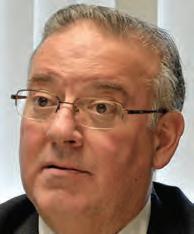
And just a few weeks ago, the Chamber announced the launch of the Queens Innovation Foundation, a nonprofit that will accelerate the growth of the tech sector in the borough and establish it as the epicenter of AI-fueled startups, emerging tech and innovation. The focus of the Queens Innovation Foundation will be build-

Additional programs will be created to help and incentivize international and domestic companies seeking to relocate to Queens, create events for world’s leading tech innovators to network and gather and upskill Queens residents for jobs in the sector.
We’ve already begun the work of showcasing what Queens can do — at this year’s Queens Business Expo there were over 140 exhibitors, including all 15 startups in the Queens Tech Incubator program in a pavilion sponsored by Google. We saw businesses using technology in surprising ways — ranging from retail establishments and restaurants to healthcare and educational institutions.
The integration of technology into the business fabric of Queens is building a vibrant, innovative, and resilient local economy. The adoption of advanced technologies is driving efficiency, enhancing customer experiences and opening up new avenues for growth. As Queens continues to embrace this digital transformation, it stands as a testament to the positive impact of technology on community and business development.
Sixty years after the World’s Fair in Flushing Meadows-Corona Park, we are primed to reestablish Queens as the global hub for innovation and entrepreneurship. Q
Tom Grech is President and CEO of the Queens Chamber of Commerce.









website: www.yourshalanaessentials.com or email us at info@youshalanaessentials.com


In the digital age, it’s often said that people have more information at their fingertips than ever before, with social media and the internet writ large connecting people across the world and making knowledge more accessible.
Though city government is not always the most forthcoming with information, Queens residents do have access to numerous city databases with information on a wide array of topics — if they know where to find it.
NYC Open Data is by far the most extensive source available to New Yorkers for information about the city. With more than 3,000 data sets, the database contains information on everything from ridership on the Staten Island Ferry to the locations of every park spray shower in the city.
Open Data, available online at opendata.cityofnewyork.us, was created as a result of a 2012 law that required city agencies to make their information available to the public on an online portal.
“I think Open Data New York City was actually leading the way, kind of since the beginning,” said Zachary Feder, program manger for Open Data NYC. “We were the world’s first open data law in 2012, and even before that, there was this collection of data called the data mine, where people could find information.
“But really, the idea of Open Data is taking information that’s used to run New York City, and making it accessible to New Yorkers, and that has continued to improve over time.”
One of the advantages of Open Data itself is that it provides a centralized place for the public to find information, as opposed to combing through individual department websites.
Among the most popular data sets, per the Open Data website, are 311 requests dating back to 2010, film permits, citywide payroll information and leading causes of death across the city.
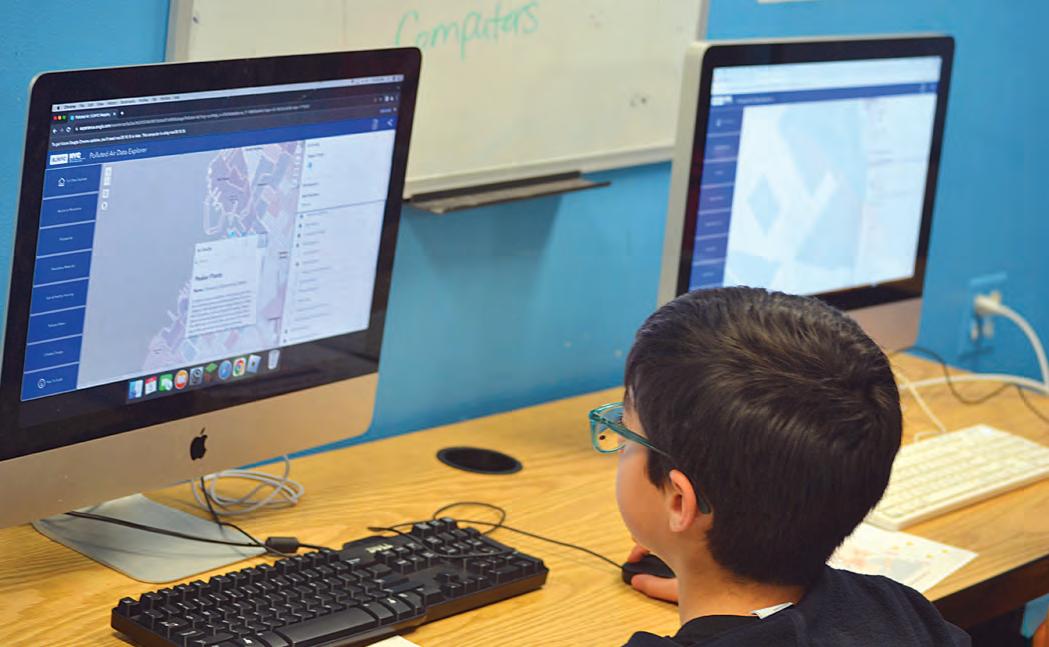
cess where agencies look at FOIL requests they’ve received, or things they posted on their website, and if they’ve shared that publicly through FOIL, if they’ve shared that on their website already, [they will share] that same information on Open Data.
“But a lot of times, we have agencies have a new program and are excited to share information on Open Data, as well.”
Among the most common ways Open Data expands its collection is by hearing directly from New Yorkers about what information they would be interested in seeing.

“One of the really cool things about Open Data is it is this sort of joint effort, participatory [process] with people all around the city and around the world, where anyone can ask a question about a data set or request a new data set,” Feder said.
of the public to understand what they are looking at.
“You have all these different, complex operations, and if you’re not somebody who’s been working on this particular program for a long time, how do you understand the nuances of how the government works in whatever area it is?” Feder said.
Though publishing a new data set from start to finish can take quite some time, new entries are added to existing sets regularly.
And while Open Data is perhaps the most comprehensive source for publicly available information about the city, it is hardly the only one of its kind.
wider audience.
“A lot of this data is has been processed and made into shape files — or into formats that are compatible with this GIS mapping tool,” Pieded said. “So a lot of data that wasn’t previously available as a visual map was made available in that format, even if it was previously existing data on Open Data.”
The mayor’s climate office is not the first to take on such a project, though. Pieded says that the Department of Health and Mental Hygiene’s database is viewed by many as the gold standard in that sense. The DOH’s system also uses maps to show trends throughout the city, illustrating birth and death rates as well as others such as air quality and how widespread air conditioners are in homes.
But that’s just the beginning. Many other maps and databases illustrate trends across the city, as well. The Department of Parks and Recreation, for instance, in 2022 launched an NYC Tree Map, showing not only where every street tree can be found in the five boroughs, but also whether it has been cared for and what kind of tree it is, among other things.
Community members can even nominate a tree in their neighborhood for top honors: being deemed one of the greatest trees in the city. That map can be found by visiting treemap.nycgovparks.org.
And within the last month, Mayor Adams celebrated the release of a public restroom map, providing New Yorkers known to live on the go with a place to go. Find that map on m3.mappler.net/nyrestroom.
Making such a wide array of data available to the public is no easy task, though, and requires cooperation and input from across city agencies. As such, every city agency and office has a point person to do just that: an “Open Data coordinator.” Feder says there about 100 of them throughout the city.
Those coordinators work with the Open Data team to determine what data sets their respective offices have on hand. But it’s a two-way street: While Open Data may ask agencies for information, sometimes, that drive to share data comes from within a department.
“There’s sort of a push and a pull, where we will go to agencies when we hear about something and ask them about the data behind it,” Feder said. Referring to the Freedom of Information Law, he continued, “For example, there is an annual reporting pro-
The city is required to provide those inquiring about specific data sets with that information — or at least respond to the request, he said.
“You’re basically guaranteed to get a response — whether it’s, ‘This data exists already, here you go, here’s a link to it,’ or ‘This data can’t be shared because it’s confidential information,’ or ‘This data set doesn’t exist yet, but guess what? We’re going to be publishing it,’” Feder explained.
But simply making the raw data available to the public does not mean it will be comprehensible to the average New Yorker. Though Open Data has both data sets and, in some cases, maps showing data geographically, not all New Yorkers are experts on subjects such as Department of Buildings permits or bus lane violations.
As such, one of the improvements Feder and his colleagues at Open Data have worked on in recent years is the inclusion of a “data dictionary” with every published set, defining terms necessary for members
One of the most recent and most extensive examples of new city databases is a mapping tool released by Mayor’s Office of Climate and Environmental Justice in early April. Using the program, city residents are able to visualize where certain environmental hazards are at their worst, such as air pollution and flooding. Much of that information is available in the corresponding report, the city’s first ever on environmental justice. Both can be found online at climate.cityofnewyork.us/topic/ environmental-justice.
The mapping tool’s 115 layers of data can each be viewed individually on Open Data, according to Carlos Piedad, the mastermind behind the program. Though “a decent chunk” of those sets were already available to the public, not all of them were.
“We’ve also brought in data from New York State as well as the federal government, and some of the data sets that were developed by the city were either developed specifically for the mapping tool or were not previously publicly available,” Piedad said. “So they are kind of making their debut through this mapping tool.”
Part of the drive to put together a mapping tool — and the 2017 law that mandated its creation — was the need for data to be both accessible and understandable to a
Those looking to keep tabs on how the city is spending taxpayer dollars can take a look at the City Comptroller’s database, known as Checkbook 2.0. Though not the most user-friendly, the site makes it possible for residents to see exactly what agencies are paying what vendors for what, and for how much.
The City Record (or its online version, known as CROL) also includes information about upcoming hearings, potential agency rules and much more. That can be found at a856-cityrecord.nyc.gov. Q









































